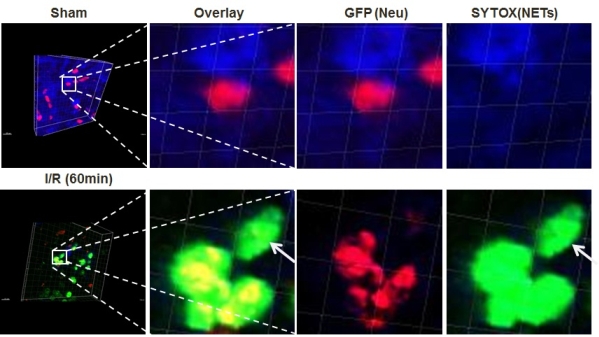Damage Associated Molecular Patterns (DAMPs)-Activated Neutrophil Extracellular Trap Formation Exacerbates Liver Ischemia/Reperfusion Injury
Department of Surgery, University of Pittsburgh, Pittsburgh, PA.
Meeting: 2015 American Transplant Congress
Abstract number: D72
Keywords: knockout, Liver, Mice, Neutrophils, Warm ischemia
Session Information
Session Name: Poster Session D: Innate Immunity in Transplantation
Session Type: Poster Session
Date: Tuesday, May 5, 2015
Session Time: 5:30pm-6:30pm
 Presentation Time: 5:30pm-6:30pm
Presentation Time: 5:30pm-6:30pm
Location: Exhibit Hall E
Liver ischemia/reperfusion (I/R) injury is a clinically important phenomenon encountered during transplantation that contributes to initial graft function and subsequent allograft rejection. Formation of neutrophil extracellular traps (NETs) has been found to be a novel response of neutrophils to various stimuli. DAMPs are released from damaged cells during liver I/R and can activate inflammatory signaling cascades. However, whether NETs participates in liver I/R injury and what their potential roles remain unknown. we sought to determine the mechanisms by which NETs are stimulated and how they contribute to the innate immune and inflammatory response during liver I/R injury.
Mice were subjected to a non-lethal partial (70%) warm liver I/R model, treated with PAD 4 inhibitor (YW4-03) or DNase I. Mouse bone marrow neutrophils were harvested and stimulated with PBS, or PMA, histones, or HMGB1, with/without PAD4 inhibitor.
NET formation was identified in real-time in the sinusoids of ischemic liver lobes by 2-photon confocal microscopy. This was associated with increased NET markers, serum level of myeloperoxidase (MPO)-DNA complexes compared to mice undergoing sham operation. Treatment with PAD4 inhibitor or DNase I conferred significant protection compared to controls after liver I/R
This was associated with increased NET markers, serum level of myeloperoxidase (MPO)-DNA complexes compared to mice undergoing sham operation. Treatment with PAD4 inhibitor or DNase I conferred significant protection compared to controls after liver I/R  , indicating the pathophysiological role of NETs in liver I/R injury. In vitro, stimulation of neutrophils directly with DAMPs, HMGB1 or histones resulted in significant NET formation and was inhibited by adding PAD4 inhibitor respectively.
, indicating the pathophysiological role of NETs in liver I/R injury. In vitro, stimulation of neutrophils directly with DAMPs, HMGB1 or histones resulted in significant NET formation and was inhibited by adding PAD4 inhibitor respectively.
Our study demonstrates that DAMPs released during liver I/R promotes NET formation through TLRs signaling pathway. Development of NETs subsequently exacerbates organ damage and initiates inflammatory responses during liver I/R injury.
To cite this abstract in AMA style:
Huang H, Tohme S, Al-Khafaji A, Tsung A. Damage Associated Molecular Patterns (DAMPs)-Activated Neutrophil Extracellular Trap Formation Exacerbates Liver Ischemia/Reperfusion Injury [abstract]. Am J Transplant. 2015; 15 (suppl 3). https://atcmeetingabstracts.com/abstract/damage-associated-molecular-patterns-damps-activated-neutrophil-extracellular-trap-formation-exacerbates-liver-ischemiareperfusion-injury/. Accessed December 30, 2025.« Back to 2015 American Transplant Congress
